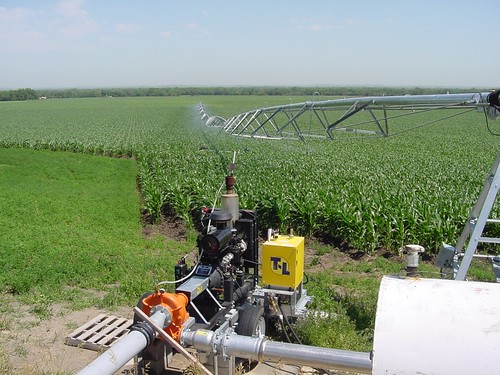
As a little girl, Mary Kay Lyon followed her father around their south central Nebraska farm always dreaming of one day owning the operation herself. Lyon left the farm to attend college, but eventually made it back home when her father retired, determined to run the family farm.
“I wanted to farm since I was old enough to walk,” Lyon said.
Lyon grows corn and soybeans and raises cattle on the farm. Upon her return, she immediately began looking for ways to make improvements. Their crops have always been watered through an irrigation system, but Lyon knew improvements were needed on the old water delivery system.
She reached out to her local service center of USDA’s Natural Resources Conservation Service, (NRCS), in Holdrege, Nebraska to discuss how to achieve her land improvement goals through conservation practices.
Lyon’s objective was to install an efficient irrigation system that used less water and more uniformly applied water across a field. At the time, she was using an inefficient gated pipe system to irrigate her crops. This system used a large pipe that was laid across the end of the field and was perpendicular to the rows. Water was pumped through the pipe and gates would open up at each row allowing water to flow down the row to irrigate the crop.
She worked with Curtis Scheele, a water quality specialist at NRCS, to take advantage of assistance available through conservation programs like the Environmental Quality Incentives Program, or EQIP, and the Conservation Stewardship Program, or CSP. NRCS conservation programs like EQIP provided her with technical and financial assistance to ensure the irrigation system was designed to meet the needs of the cropland, while delivering irrigation water in the most efficient manner possible.
Lyon installed a center pivot irrigation system. Pivot irrigation acts like a large sprinkler system that irrigates crops from water nozzles suspended above the crop. Pivots use much less water than other irrigation methods. Because one of Lyon’s fields is shaped like a rectangle, the swing arm of the center pivot covers each corner. The pivot will pull the arm in as the irrigation approaches the road, conserving water.
“A center pivot is 90 percent efficient compared to the gravity pipeline, which is only 50 percent efficient in getting water on the crops,” Scheele said. “By installing a center pivot, Mary Kay is able to apply fewer inches of water to her cropland. By using these programs to install more efficient irrigation systems, less water is required and there has been a decreased amount of erosion and run off.
CSP is a conservation program geared toward farmers wanting to take their conservation efforts to the next level. Through CSP, she installed a remote monitoring system for her center pivots, which increased the operating efficiency more by allowing her to monitor water performance from her computer or cell phone.
Conservation programs helped Lyon make other conservation improvements to her farm, including the use of no-till practices and repairing a decades-old windbreak.
No-till is when farmers don’t disc the soil when planting, only punching a small hole needed for a seed. As a result of farming with no-till methods, Lyon said she makes less passes across the field with her tractor. Over time, no till farming increases infiltration of water into the soil, increases water holding capacity of soil and organic matter in topsoil.
She also repaired the old windbreak, enabling it to better protect the farm and calving pens from the cold, while also providing shade for livestock in the summer. NRCS provided financial assistance for her to tear out the old windbreak trees and replace them with two new rows of cedars and pines.
